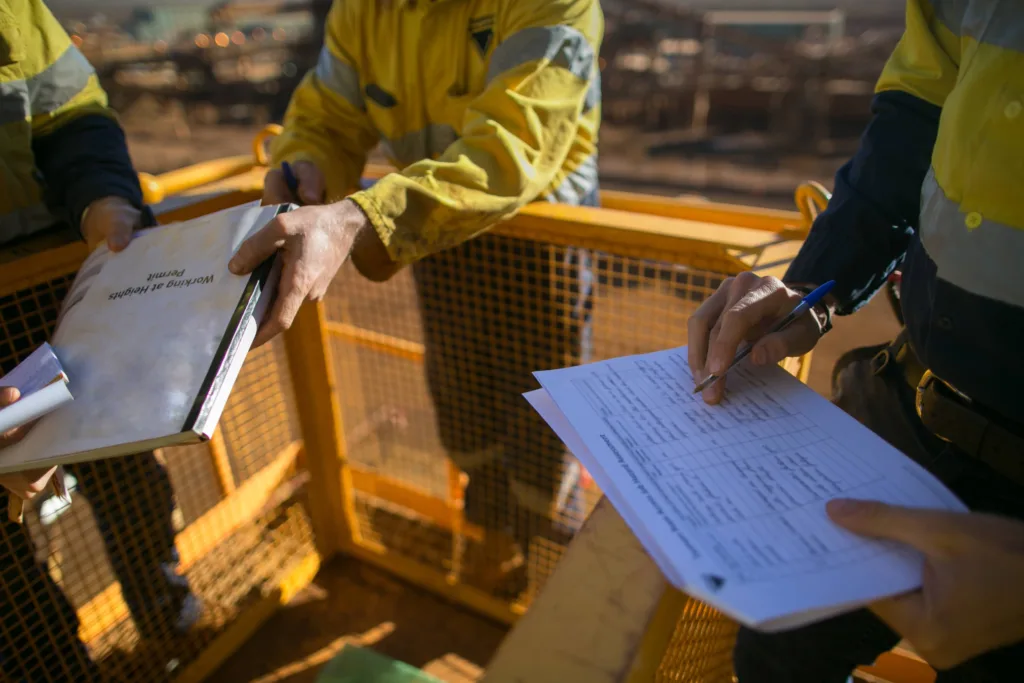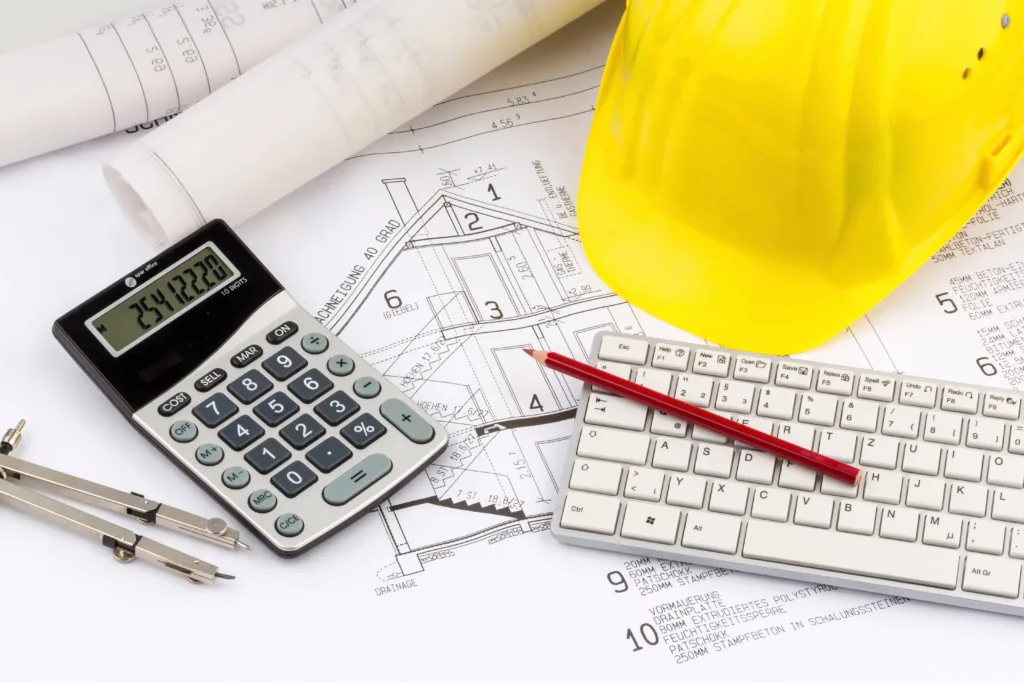In the fast-paced and dynamic construction world, managing costs effectively is not just an advantage – it’s a necessity. Whether you are overseeing a minor renovation or a large commercial project, budgets can quickly spiral out of control without careful planning and vigilance. So, how can you manage construction project costs and keep your project on track financially?
The short answer: successful construction cost management involves accurate early-stage estimates, diligent real-time tracking of budget items, effective use of construction management software, proactive risk assessments, and adopting a culture of continuous improvement.
In this comprehensive guide, we will unravel the complexities of construction cost management. We will start by defining construction cost management and its critical components – from labor and materials to overhead expenses. We will explore the potentially severe consequences of neglecting cost management, which range from financial losses to reputational damage.
This guide doesn’t just highlight the pitfalls; it’s packed with practical advice. We will walk you through the process of selecting the best construction management software that aligns with your project’s needs, setting accurate and reliable cost estimates from day one, and adopting the best practices to track your budget in real-time.
Moreover, this article will guide you on streamlining change orders, mastering the art of contract negotiation, considering sustainable building practices, and regularly reviewing and adjusting your strategy in a continuous improvement loop.
By the end of this guide, you will have 10 actionable tips for controlling your construction project costs, mitigating risks, and steering your projects toward financial success.
So, let’s dig in and set the foundation for your next project to be completed on time and within budget.
Table of Contents
1. Demystifying Construction Cost Management
What does ‘construction cost management’ mean to you? For some, it might conjure images of spreadsheets filled with endless numbers, while others might envision a project manager firmly steering the ship through a storm of expenses and invoices. Despite your perspective, construction cost management is an essential, multifaceted practice that every project leader must master.
What is Construction Cost Management?
At its core, construction cost management is the process of planning, monitoring, and controlling the budget of a construction project. This isn’t just about crunching numbers; it’s about making strategic decisions that influence the financial outcome of a project from start to finish.
Components of Construction Costs
When we break it down, construction costs generally consist of materials, labor, equipment, overhead, and contingencies. Here’s a more detailed look:
- Materials: The tangible items needed to construct the project physically. This includes everything from concrete to nails.
- Table: Breakdown of Typical Material Costs
- Labor: The cost of human work. This varies widely based on location, the complexity of the work, and other factors.
- Equipment: The cost of renting or buying construction equipment necessary for the project.
- Overhead: These are the indirect costs of running a project, including administrative expenses, office rent, utilities, etc.
- Contingencies: The budget set aside to cover unexpected costs during the project. This is your financial safety net.
The Heart of the Matter
The true essence of construction cost management lies in being proactive, not reactive. This means developing a detailed and realistic initial budget, closely tracking costs as the project progresses, and making data-driven decisions to avoid costly overruns.
Why is it Critical?
Effective cost management is the linchpin that can make or break a project in an industry where profit margins are often thin and construction projects are inherently risky. It provides:
- A clear financial pathway.
- Helping teams to complete construction projects on time and within the allocated budget.
- Ultimately safeguarding the profitability and reputation of the company.
In conclusion, construction cost management is far from a mundane administrative task—it is the strategic heartbeat of every successful construction project. It’s about foresight, using effective cost control methods, and steering your project clear of financial turmoil.
So, as you embark on your next construction project, remember that cost management isn’t a one-time task – it’s a continual process that demands attention and skill.
2. The Perils of Neglecting Cost Management in Construction
Let’s paint a picture. Imagine you’re leading a construction project that’s seemingly progressing well. But then, as the completion date nears, you suddenly realize the full project costs will exceed the budget—by a lot. Panic sets in. How did this happen? The likely culprit is neglect of thorough construction cost management.
The Consequences: More Than Just Financial Loss
While going over budget is a primary concern for project owners, the consequences of poor cost management in construction can ripple far and wide, affecting not just your bottom line but your company’s entire reputation. Here are the major pitfalls:
- Financial Loss: The most immediate and clear consequence. When costs spiral, profits plummet.
- Reputational Damage: Overshooting budgets can tarnish your company’s reputation, making winning future bids and maintaining client relationships hard.
- Legal Consequences: Exceeding the budget may lead to disputes with clients or subcontractors, potentially resulting in costly legal battles.
- Stress and Low Morale: Persistent budget issues can create a stressful environment for the team, leading to low morale and high turnover rates.
- Graph: Comparing Projects with Good and Poor Cost Management
Real-World Examples: A Hard Lesson
To move beyond the theoretical, consider the case of a large city infrastructure project that, due to a lack of rigorous construction cost management, ran a staggering 70% over budget. This overrun led to scaled-down project scope, strained stakeholder relationships, and significant reputational harm for the firms involved.
The Domino Effect
Neglecting cost management creates a domino effect. One small oversight can lead to another until the whole project is teetering on the brink of financial disaster. That’s why effective construction cost management isn’t just a part of the project—it’s integral to the entire process.
Prevention is Better Than Cure
In construction, firefighting is costly. It’s far more efficient to prevent budget overruns from happening in the first place. That’s where diligent, proactive cost management shines. It’s the tool that allows you to spot potential cash flow issues long before they morph into full-blown crises.
In summary, neglecting cost management in construction is akin to sailing a ship without a compass—you might stay afloat for a while. Still, eventually, you’re likely to veer dramatically off course.
So, as the stakes are high, it’s essential to place cost management at the center of your project strategy, ensuring that your project doesn’t just start strong but stays strong.
3. Digitize Your Workflow with Construction Management Software

Picture this: it’s Monday morning, and your desk is drowning in a sea of papers—contracts, invoices, schedules, and estimates. Sound familiar? In the digital age, this doesn’t have to be your reality. Enter construction management software. This is not just a tech buzzword; it’s your pathway to smoother, more efficient construction cost control.
Why Make the Switch to Digital?
In a world where our smartphones are virtually an extension of ourselves, it’s surprising how many construction projects are still managed with pen and paper. Adopting construction management software isn’t just about going digital—it’s about revolutionizing how you handle your project’s finances.
- Efficiency: Automate tedious tasks and free up your team to focus on what really matters: building.
- Accuracy: Eliminate human error from manual data entry, ensuring your budgets and forecasts are spot-on.
- Real-time Insights: Track expenses as they occur, making it easier to stay on top of your budget and make data-driven decisions.
- Collaboration: Foster teamwork by enabling all stakeholders to access and update project information in real-time.
- Table: Comparing Features of Popular Construction Management Software
Choosing the Right Software for Your Needs
Not all construction management software is created equal. Selecting the right tool involves considering your project’s size, complexity, and specific needs. Look for user-friendly, customizable software that integrates well with your other devices.
- Understand Your Needs: List the non-negotiable features for your projects.
- Research and Compare: Dive into reviews, request demos, and compare features and pricing.
- Test Before You Commit: Many providers offer free trials. Use this to ensure the software fits your workflow seamlessly.
Implementation: More Than Just Installation
Getting new software up and running isn’t just about clicking ‘install.’ It’s a process that involves training your team, migrating data, and setting up your workflows within the system. Proper implementation of construction management software is just as critical as the selection process.
The Bottom Line: A Smart Investment
While there’s a cost associated with adopting new software, consider this an investment in your project’s future. The efficiencies you gain will likely offset the initial outlay, making this a wise financial decision in the long run.
In summary, construction management software isn’t just a ‘nice-to-have’—it’s a game-changer that could spell the difference between a project that runs like a well-oiled machine and one that spirals into chaos.
So, why wait? Start exploring your options, and take the first step towards digitizing your construction management workflow today.
4. Starting Strong: Setting Accurate Cost Estimates from Day One

Imagine building a house on a shaky foundation. It might stand for a while, but eventually, it will have big problems. The same goes for your construction project’s budget. If your initial cost estimates are off, it sets the stage for a rocky road ahead. So, how do you ensure your project starts on solid financial ground?
The Art and Science of Cost Estimating
Cost estimating in construction is both an art and a science. It requires a detailed understanding of cost details of the project, proper planning, a dash of experience, and a sprinkle of foresight.
- Detail-Oriented Approach: Start with a meticulous breakdown of every project component, from materials and labor to permits and overhead costs.
- Historical Data: Past projects can be a goldmine of information. Analyze them to inform your current estimates.
- Contingency Planning: Always include a contingency in your estimates. This isn’t pessimism; it’s being prepared for the unexpected.
Common Pitfalls and How to Avoid Them
Accurate cost estimating is a skill honed over time, and even seasoned industry professionals can stumble. Here are some common accurate estimating traps and how to sidestep them:
- Underestimating Labor Costs: Don’t just focus on material prices; labor is often a significant portion of the budget.
- Ignoring Price Fluctuations: Costs of materials can vary. Keep an eye on market trends and adjust your estimates accordingly.
- Overlooking Soft Costs: These indirect costs, such as legal fees and administrative expenses, are easy to forget but add up quickly.
- Graph: Breakdown of Common Cost Estimating Errors
The Power of Professional Input
When it comes to cost estimates, two heads (or more) are often better than one. Consider involving specialists, such as quantity surveyors or cost engineers, early in the cost control process. They bring a level of expertise that can be invaluable in setting realistic budgets.
Be Ready to Revise
The construction industry is dynamic, and your initial estimates aren’t set in stone. As the project progresses, revisit and adjust your estimates as needed. This isn’t admitting defeat—it’s intelligent, adaptive management.
The Bottom Line: Accuracy is Non-Negotiable
In construction, starting with accurate cost estimates isn’t just a helpful starting point—it’s a critical foundation for the entire project. It guides every decision you make after that, from which contractor to hire to how to allocate resources efficiently.
In summary, meticulous and informed cost estimating from day one sets your construction project on the path to success. If done right, the blueprint helps you build strong, avoid unnecessary stress, and deliver a project that meets quality standards and budget expectations.
So, before laying the first brick, lay the groundwork with precise, comprehensive cost estimates. Your future self—and your project’s bottom line—will thank you.
5. Keep Your Finger on the Pulse: Tracking Budget Items in Real-Time

Have you ever tried cooking a new recipe without checking the stove? Spoiler alert: that’s a recipe for disaster. In construction, your budget is your recipe; real-time tracking is your vigilant eye on the stove. Constant, immediate updates on your budget items are not a luxury but a necessity.
The Why and How of Real-Time Tracking
Let’s explain why real-time tracking is the sous-chef you never knew you needed and how to employ it effectively.
- Immediate Corrections: Spot discrepancies before they snowball into costly errors. Real-time data lets you make adjustments on the fly, not after the fact.
- Informed Decisions: With up-to-date information, you can make confident and timely choices grounded in facts, not assumptions.
- Graph: The Impact of Real-Time Tracking on Budget Adherence
Tools of the Trade: Software to the Rescue
There’s a digital tool for nearly every aspect of modern life, and construction budget tracking is no exception. Here are some functionalities to look for:
- Expense Tracking: Log and categorize expenses as they happen.
- Alerts and Notifications: Set up triggers to alert you when certain budget items are nearing their limits.
- Integration with Other Systems: The best tools play nicely with your other software, such as accounting systems or project management platforms.
Case Study: A Tale of Two Projects
Consider two construction project managers here: Alex and Jordan. Alex relies on monthly budget reports, while Jordan uses real-time software that updates budget data. When a surprise expense hits, Jordan adjusts immediately, while Alex only learns of it weeks later. Who do you think stayed within budget?
The Human Element: Training and Adoption
Real-time tracking tools are fantastic, but they’re only as good as those using them. Training your team on these systems is vital, emphasizing the importance of timely and accurate data entry.
Don’t Neglect the Big Picture
While it’s essential to track individual budget items closely, don’t lose sight of the overall financial health of your project. Regularly step back and assess how the pieces are fitting together.
The Bottom Line: Staying Ahead, Not Just Afloat
Real-time budget tracking is akin to having a crystal ball in the fast-paced construction world. It allows you to see into your project’s financial future, giving you the power to steer the ship proactively rather than reacting to storms when they hit.
In summary, keeping your finger on the pulse of your project’s finances through real-time tracking isn’t just bright—it’s an essential strategy for avoiding costly surprises and ensuring the project stays on course.
So, don’t wait for the monthly report to know where your project stands financially. Keep your finger on the pulse, and let real-time tracking guide your project to success.
6. Navigating Changes Smoothly: Streamlining the Change Order Process

Think of a change order as a plot twist in your favorite novel: unexpected, sometimes challenging, but crucial to the story. Change orders are inevitable in construction, but they don’t have to spell disaster. The key is a streamlined process that turns a potential headache into a manageable, well-organized task. Let’s explore how to navigate these twists like a seasoned novelist.
Why Change Orders Happen
First, let’s demystify change orders. They’re not always a sign of trouble; they’re a normal part of construction projects that can arise from various factors:
- Design Revisions: Creative changes or unforeseen site conditions can trigger modifications.
- Regulatory Requirements: Updated codes or overlooked permits might necessitate changes.
- Client Requests: Sometimes, clients change their minds, which means the project needs to adapt.
Crafting a Clear Change Order Protocol
To smoothly navigate through change orders, think of yourself as a ship’s captain steering through a storm—you need a solid protocol:
- Document Everything: Each change order should be written and include the scope of change, additional costs, and revised timeline.
- Get Approvals in Writing: Ensure all stakeholders sign off on a change, avoiding disputes later.
- Communicate Effectively: Keep all parties— from your team to the client— in the loop regarding the change order status.
- Table: Steps of a Well-Defined Change Order Protocol
Technology as Your First Mate: Leveraging Software
Modern construction management software often includes change order tracking features. These tools can automate much of the process, making submitting, reviewing, and approving changes easier. They can be your best ally in keeping change orders organized and transparent.
The Cost Factor: Managing the Budget Amid Changes
Change orders often come with a price tag. Here’s how to handle the budgetary aspect:
- Set a Contingency Fund: Allocate a percentage of the project budget for change orders.
- Regularly Review the Budget: Following a change order, revisit the budget to ensure it aligns with the new project trajectory.
The Bottom Line: Change is a Constant, Not a Crisis
In the ever-evolving landscape of a construction project, change orders are par for the course, not a curveball thrown to disrupt your game. A streamlined process allows you to manage changes efficiently, keeping the project on track without unnecessary stress.
In summary, change orders are a regular, often unavoidable part of construction. With a precise protocol, solid communication, and the right tools, navigating these changes can be as smooth as a well-rehearsed dance.
So, the next time a change order comes your way, see it as an opportunity to showcase your project management prowess, not as a daunting obstacle. After all, every good story has its twists and turns.
7. Be Prepared, Not Scared: Conducting a Risk Management Assessment

Imagine going on a grand adventure—you wouldn’t embark without a map, right? In the world of construction, a Risk Management Assessment is your map. It helps you foresee pitfalls and equip your team with the right tools and plans to navigate them. Here’s your guide to setting up a Risk Management Assessment that acts like your project’s GPS.
Understanding the Terrain: What is a Risk Management Assessment?
A Risk Management Assessment is a systematic approach to identifying, analyzing, and preparing for potential risks affecting your construction project. Think of it as your early warning system, alerting you to storms ahead so you can steer clear or brace for impact.
- Identification: Spot the potential hazards before they spot you.
- Analysis: Weigh the potential impact of each risk.
- Preparation: Develop strategies to mitigate or avoid these risks.
- Table: Example Risks and Mitigation Strategies in Construction
The Essential Tools: Your Risk Assessment Kit
Just as a seasoned explorer wouldn’t venture into unknown terrain without a compass and map, your risk assessment should be backed by a set of tools:
- Checklists: A comprehensive list of potential risks specific to your project type.
- Software Solutions: Tools that facilitate risk analysis and track your mitigation efforts.
- Expert Consultations: An experienced eye can sometimes spot risks that a checklist might miss.
Steps to Solid Footing: Conducting the Assessment
Conducting a Risk Management Assessment isn’t a one-time event; it’s an ongoing process. Here are the steps to keep your construction project on solid footing:
- Establish the Context: Understand the specific environment your project operates in.
- Identify Risks: Use your tools to find potential threats.
- Analyze and Evaluate: Assess the likelihood and impact of these risks.
- Develop Strategies: Create plans to mitigate or avoid significant risks.
- Monitor and Review: Regularly revisit your assessment and adjust as necessary.
The Bottom Line: Risk is Part of the Journey, Not the End of the Road
In the grand adventure of construction, risks are the unknown territories on your map, not monsters lurking to derail your journey. A well-prepared Risk Management Assessment enables you to face these uncertainties confidently, not fearfully.
In summary, a Risk Management Assessment is not about predicting every obstacle—it’s about being prepared to adapt and respond effectively when challenges arise.
So, before breaking ground on your next project, chart your course with a thorough Risk Management Assessment. The blueprint helps you build success on a foundation of preparedness, not surprises.
8. Negotiate Wisely: Mastering the Art of Contract Negotiation

Picture this: You’re at a bustling marketplace, surrounded by vibrant goods stalls. You spot something you want, but you know the price is just the starting point. Welcome to contract negotiation in the construction world—it’s an art form, and you’re the artist, paintbrush in hand. Here’s how to paint a fair, transparent masterpiece that sets the tone for a successful project.
Why Negotiation Matters: It’s More than Just Dollars and Cents
Contract negotiation isn’t merely about costs—it’s about shaping the relationships and expectations that will steer your project’s success. It’s the blueprint of your collaboration.
- Setting Boundaries: Clearly defining the scope and responsibilities of each party.
- Managing Expectations: Aligning visions and goals for the project.
- Avoiding Surprises: Crafting clauses that anticipate and address potential challenges.
The Key Principles: Your Palette of Tactics
Here’s your palette—the principles that guide the strokes of your negotiation brush:
- Preparation: Know your project inside and out, and understand what you can and can’t compromise on.
- Transparency: Be open and clear about your terms; avoid hidden clauses or complex language.
- Flexibility: Be ready to adapt and find a middle ground, painting a win-win solution for all parties involved.
Brushstrokes of Success: Steps in Contract Negotiation
To create a contract that’s an actual work of art, follow these methodical steps:
- Research: Understand your client, the market rates, and recent industry trends.
- Draft the Initial Contract: Create a detailed, transparent, and fair proposal.
- Review and Revise: Listen to the other party’s feedback and make revisions accordingly.
- Negotiate Terms: Engage in dialogue, aiming for a contract that satisfies both parties.
- Finalize and Sign: Once an agreement is reached, ensure it is signed and legally binding.
- Table: Common Contractual Clauses and Their Implications
Avoiding the Pitfalls: Common Mistakes in Contract Negotiation
Even master artists can slip up. Here are potential pitfalls and how to avoid them:
- Rushing the Process: Patience is vital; avoid the urge to speed through negotiations.
- Not Seeking Legal Advice: A lawyer’s perspective can prove invaluable.
- Ignoring the Fine Print: Every detail matters—don’t let a minor clause cause major headaches later.
The Bottom Line: Contract Negotiation is Your Canvas, Not Your Battle Ground
Remember this vital truth: Negotiating a contract is about crafting a partnership, not winning a battle. It’s the canvas for your project, where both parties come together to create something spectacular.
In summary, contract negotiation in the construction business is an art of balance and communication. It requires preparation, transparency, and the ability to adapt, with the end goal of a harmonious and productive partnership.
So, as you approach your next negotiation, see it as an opportunity to compose a brilliant scene in the story of your project, not as a stressful standoff.
9. Sustainable Building: Cost Savings through Green Construction

Picture your next construction project as a thriving, lush garden. It’s not just visually appealing; it’s also nourishing the environment and, believe it or not, your budget. Welcome to the world of green construction—a harmonious blend of sustainability and savings that’s increasingly becoming the industry’s golden standard. Let’s dig in.
Green is the New Gold: Why Sustainability Matters
Green construction isn’t a fleeting trend—it’s a transformative approach to building that focuses on long-term efficiency and environmental harmony.
- Less is More: Sustainable practices often use fewer resources, translating into cost savings.
- Investment in the Future: Upfront costs may be higher, but the long-term savings on energy and maintenance are substantial.
- Market Appeal: Consumers are becoming more eco-conscious. A green project isn’t just ethical; it’s also a strong selling point.
The Toolkit: Essential Elements of Green Construction
Your toolkit for green construction is rich with options:
- Energy Efficient Designs: Maximizing natural light, superior insulation, and innovative HVAC systems.
- Sustainable Materials: Opt for recycled, reclaimed, or rapidly renewable materials.
- Water Conservation Systems: Harvesting rainwater, greywater systems, and drought-resistant landscaping.
- Graph: Long-Term Cost Savings from Green Construction Elements
The Green Blueprint: Steps to Sustainable Building
Here’s your path to cultivating that flourishing construction ‘garden’:
- Plan for Sustainability: From day one, integrate green goals into your project.
- Choose the Right Materials: Research and select durable and eco-friendly materials.
- Implement Energy-Saving Technologies: Invest in solar panels, energy-efficient appliances, and intelligent systems.
- Monitor and Adjust: Use software to track the project’s environmental impact and make adjustments as necessary.
- Seek Certifications: Consider aiming for LEED or other green certifications that can add value to the project.
Savings that Grow: The Economic Benefits of Green Construction
Plant a seed, and watch your savings grow. Here are the vital economic advantages:
- Lower Operating Costs: Energy-efficient buildings often have lower utility bills.
- Tax Incentives: Many governments offer tax benefits for sustainable construction.
- Enhanced Property Value: Green certifications can significantly boost a property’s market value.
The Bottom Line: Green Construction is Prosperity in Harmony
Green construction is about forging a balance—a way to prosper harmoniously with the earth. Building sustainably doesn’t mean sacrificing profitability; it’s about shaping a future where your business and the environment can thrive.
Green construction is a wise, forward-looking approach that aligns ethical responsibility with financial prudence. It’s an investment in a future where the buildings we create are as healthy as the bottom lines we aim for.
So, as you sketch out your next project, consider how a green approach could sow the seeds of success that will yield a rich harvest for years to come.
10. Regularly Review and Adjust: The Continuous Improvement Loop

Imagine you’re steering a ship through ever-changing seas. You can’t just set your course and forget about it to reach the desired destination. Instead, you must frequently check your compass, observe the conditions, and adjust as needed. Managing construction costs is no different. It’s a voyage that requires you to be in the captain’s seat, continually steering toward financial efficiency. Here’s your navigator’s guide to the continuous improvement loop in construction cost management.
Setting the Course: Why Regular Review Matters
Constant vigilance is your trusted compass in navigating the budgetary oceans of a construction project. Here’s why:
- Staying on Course: Regular reviews ensure your project meets its budget and goals.
- Spotting Storms Early: By consistently checking the numbers, you can identify issues before they escalate into full-blown crises.
- Optimizing for Smooth Sailing: Regular adjustments allow you to refine processes, trim excess costs, and streamline operations.
Your Sextant and Compass: Tools for Continuous Review
For accurate navigation, arm yourself with these essential tools:
- Budget Tracking Software: Utilize technology that offers real-time insights into your spending.
- Financial Reports: Develop a routine of consistent and detailed financial reporting.
- Performance Metrics: Set and monitor Key Performance Indicators (KPIs) that align with your project’s goals.
- Table: Sample KPIs for Construction Cost Management
Navigating the Waters: Steps in the Continuous Improvement Loop
Keep your construction project sailing smoothly with these iterative steps:
- Plan: Establish your budget and financial goals with precision.
- Execute: Implement your plan, utilizing your tools and resources effectively.
- Monitor: Regularly check your budget, expenses, and performance metrics.
- Analyze: Use your data to spot trends, issues, and opportunities.
- Adjust: Make data-driven decisions to realign and optimize your project’s financial path.
Learning from the Voyage: The Power of Post-Project Analysis
After your project concludes, the journey isn’t over:
- Conduct a Post-Mortem Analysis: What worked well? What didn’t? Identify lessons for future projects.
- Document and Archive Data: Ensure your findings are accessible for future reference and continuous improvement.
- Celebrate the Successes: Acknowledge what went right and give credit where it’s due.
The Bottom Line: Steering Towards Success, One Adjustment at a Time
In the end, successful cost management in construction is about being an adept and attentive captain. It’s not a set-it-and-forget-it endeavor; it’s a dynamic process of continual assessment and refinement.
In summary, the continuous improvement loop in construction cost management is a proactive, iterative approach that keeps your project on course, financially sound, and poised to navigate the inevitable changes and challenges with agility and foresight.
So, as you captain your next construction project, embrace the role of a diligent navigator—steadfastly adjusting your course towards success every step of the way.
Final Thoughts and Best Practices: Steering Your Construction Ship to Calm Waters
As we wrap up this guide, picture yourself at the helm of a finely crafted ship—your construction project. The sea is vast and, sometimes, stormy, but with a steadfast hand and keen eye, you are navigating towards the promise of calm waters and a prosperous shore. Managing construction costs is your map and compass, your most essential tool in this rewarding journey.
The Heart of the Matter: Cost Management is Integral, Not Optional
Let this be your mantra: Construction cost management is not a peripheral task—it’s the heart that pumps life into the whole project lifecycle. Here are some key takeaways:
- Proactive, Not Reactive: Cost management begins on day one, not when problems arise. Being proactive is being in control.
- Precision is Key: Your estimates, plans, and budgets should be as precise as a masterfully crafted blueprint.
- Adaptability is Your Ally: The construction landscape will change; your ability to adapt is your secret weapon for survival and success.
The Golden Rules: Best Practices for Stellar Cost Management
As a seasoned captain, keep these golden rules inscribed in your logbook:
- Know Your Numbers: Understand your budget inside and out. Transparency and clarity are non-negotiable.
- Embrace Technology: Modern problems require modern solutions. Construction management software is not a luxury—it’s a necessity.
- Regular Reviews are Your Best Friend: Schedule them. Stick to them. Learn from them.
- Negotiate with Wisdom and Fairness: Contracts are the backbone of your project. Please treat them with the respect they deserve.
- Green is Gold: Sustainable building practices aren’t just good for the earth and your bottom line.
- Graph: The Correlation between Sustainable Practices and Long-Term Savings
A Smooth Sail to a Bright Future
Remember, construction cost management is less about crunching numbers than charting a course for success. It’s a living, breathing part of your project—a process that demands attention, respect, and care.
In summary, effective construction project cost control and management is your steadfast ally in transforming bold visions into magnificent realities. The disciplined, vigilant eye ensures your project stays afloat and sails triumphantly into the sunset of completion.
As you set sail on your next construction venture, may your compass be accurate, your course steady, and your resolve unwavering. Here’s to calm seas and prosperous journeys ahead!
Conclusion: Charting a Course for Success in Construction Cost Management
We began this voyage with a straightforward question: How do we manage construction costs effectively? And as we’ve navigated through the complexities and intricacies of the process, one truth stands clear—managing construction costs is akin to captaining a ship through calm and turbulent seas.
Our exploration unveiled that construction cost management isn’t a task on a checklist. It’s an art and a science, a discipline that requires continuous attention, a keen eye for detail, and a resilient approach that can weather any storm.
Here are the vital navigational stars that we’ve charted in our journey:
- Embrace Technology: In today’s fast-paced construction world, leveraging cutting-edge construction management software is non-negotiable.
- Be Proactive: Setting accurate cost estimates from the beginning lays the foundation for a successful project.
- Adapt and Overcome: The construction environment is dynamic. Real-time budget tracking and an efficient change order process are your allies in adapting to this ever-changing landscape.
- Green is the New Gold: Sustainable building practices contribute to a healthier planet and often translate into significant cost savings.
It’s a journey that asks for diligence and determination, but the reward—a thriving, on-budget, and high-quality construction project—is a prize well worth the endeavor.
So, as you prepare to hoist the sails on your next construction project, remember that the winds and waves are inevitable. Still, with sound construction cost management practices, the promise of a safe and successful journey lies within your grasp.
Mastering construction cost management is your map to steering projects to completion with skill, confidence, and grace—a true captain’s triumph.
Thank you for joining us on this comprehensive voyage through construction cost management. This guide will serve as a trusted compass as you chart your course toward success and maximize profits in all your future building endeavors.
Use Bauwise construction cost management software
Manage your construction project costs with ease and improve construction cost control process in every step of the way. With Bauwise, project managers can avoid cost overruns, make sure their construction budget does not exceed what was planned, and keep project stakeholders updated all the time.
About the Author

Mikk Ilumaa
Mikk Ilumaa is the CEO of Bauwise, a leader in construction financial management software with over ten years of experience in the construction software industry. At the helm of Bauwise, Mikk leverages his extensive background in developing construction management solutions to drive innovation and efficiency. His commitment to enhancing the construction process through technology makes him a pivotal figure in the industry, guiding Bauwise toward setting new standards in construction financial management. View profile
Related posts
Read our articles where you can find useful and relevant information about construction cost management:
- Ultimate guide to construction cost management
- Construction cost management: All you need to know
- Tips to Improve Construction Cost Management
- 10 Ways to Track Construction Project Costs
- Understanding the 5 Types of Construction Project Costs
- Mastering Construction Cost Planning in Construction Projects






